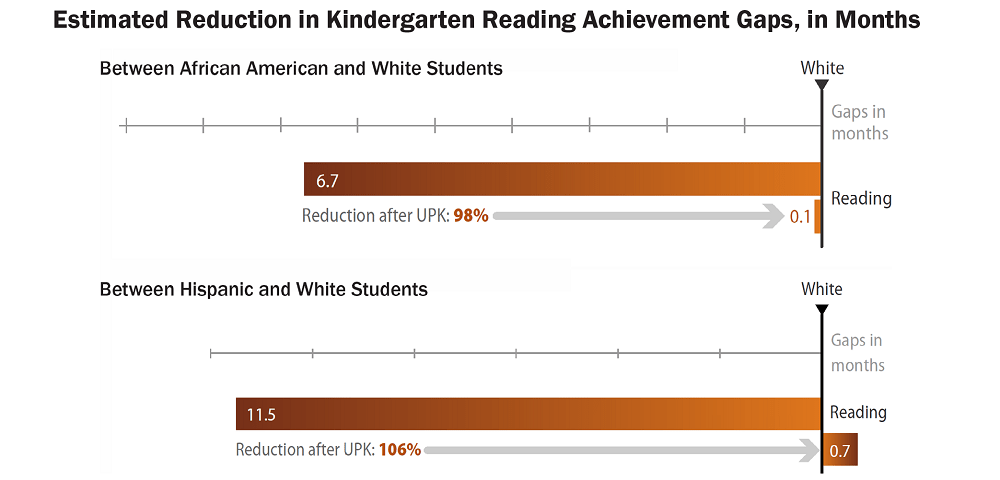Expanding Early Childhood Education: How States and Districts Can Use Federal Recovery Funds Strategically

Related Fact Sheets
In this series of fact sheets, policy experts discuss how states and districts can strategically develop, implement, and refine plans for investing federal recovery funds.
The Coronavirus Response and Relief Supplemental Appropriations Act (CRRSAA), enacted in December 2020, and the American Rescue Plan Act (ARPA), enacted in March 2021, provide states and local educational agencies (LEAs) with $176.3 billion through the Elementary and Secondary School Emergency Relief Fund (ESSER II and ESSER III). These laws provide great flexibility for both states and LEAs (including districts) in the use of funds. LEA funds can be spent on any educational expense allowed under
- the Elementary and Secondary Education Act (ESEA),
- the Individuals With Disabilities Education Act (IDEA),
- the Perkins Career and Technical Education Act, and
- other specific allowable uses (Section 313(c)–(d); Section 2001(d)–(e)).
ARPA requires that 20% of LEA funds and 5% of state funds be allocated to address learning recovery and that states must also set aside 1% of funds each for after-school programming and summer enrichment. States and LEAs have until September 30, 2023, and September 30, 2024, to obligate CRRSAA and ARPA funds, respectively, and at least 120 days after those deadlines to spend the funds. States and districts have the opportunity to use CRRSAA and ARPA funds not only to meet short-term needs but also to make longer-term investments to close opportunity and achievement gaps.
Early Childhood Education Is a High-Impact Use of Federal Recovery Funds
Early childhood education (ECE) programs provide one of the highest returns on investment of any educational spending. Quality ECE programs can help reduce special education placements and improve children’s readiness to learn. ECE is also a promising way for districts to accelerate learning, since learning gaps for students are largest when they arrive at kindergarten. These gaps are likely to have grown in the wake of COVID-19, as preschool enrollment dropped among children from low-income families by more than 20%, with just 14% of children from very low-income families attending preschool in 2020.
Federal Recovery Funds Can Be Used for ECE in School- and Community-Based Settings
Federal recovery funds can be used to fund ECE programs for children from birth through kindergarten, consistent with ESEA. These programs can be located on school campuses, but they can also be in community-based settings in a district’s attendance zone, including local Head Start, child care, and preschool programs. States and LEAs may use CRRSAA and ARPA funds for ECE in many ways, including:
- Classroom-based instructional programs
- Salaries and benefits for teachers and other staff
- Extended-day programs in Head Start or community-based child care programs
- Professional development for early childhood professionals who serve Title I–eligible children, including providers in non-school settings
- Summer enrichment programs for young children and their families
- Support services, such as nutrition, vision, dental, and counseling services
- Screening and diagnostic assessments
- Transition programs
- Parental involvement initiatives and home visiting programs
- Transportation
- Data collection and sharing
Some investments, such as professional development and summer transition programs, may be better suited to one-time funding than others.
ECE Programs Receiving Federal Funds Must Meet Certain Requirements
As explained in a brief by the Center for Law and Social Policy, federally funded ECE programs can be targeted to at-risk children, or they may be school- or districtwide as long as at least 40% of students in the attendance area are from low-income families. Children may also be automatically eligible for federally funded ECE programs if, for example, they participate in Head Start or are experiencing homelessness. Consistent with ESEA and to ensure quality, ECE programs using federal recovery funds must comply with Head Start’s educational standards. To ensure continuity and partnership across ECE programs, schools and districts using Title I funds for ECE must describe how they will “support, coordinate, and integrate” ECE services with other early learning providers and how programs will smooth students’ transitions to elementary school.
Federal Recovery Funds Can Be Used for Staff Employed in Community-Based Settings
CRRSAA and ARPA funds can be used to support professional development for any staff who support federally funded ECE programs, whether or not staff are employed by the district. For example, Title II of ESEA allows professional development funds to be used to support joint professional development of district- and community-based ECE staff serving children in a Title I attendance zone. Federal recovery funds can similarly support these opportunities. Joint professional development can support equitable learning opportunities across settings.
States Can Support Districts’ Use of Federal Funds for ECE With Clear Guidance
States can support high-leverage LEA investments by providing LEAs with guidance on how to use their federal funds, including recovery funds under CRRSAA and ARPA, to support early learning. State department staff and guidance documents can clarify the many ways funds can be used for ECE and offer suggestions on how to build community partnerships, such as through sample memoranda of understanding and district examples. California’s First 5 Commission, for instance, provided small planning grants between 2001–02 and 2005–06, which nearly doubled the number of districts using Title I funds for ECE and increased total Title I funding for ECE by 76%. Washington state currently provides LEAs with guidance on how to use Title I, Part A funds for early learning programs and explains why they are beneficial. Districts, in turn, have flexibility to use funds in a variety of ways.

Source: Friedman-Kraus, A. (2016). How much can high-quality universal pre-k reduce achievement gaps? National Institute for Early Education Research.
Districts Can Look to Current Uses of Title I Funds as Examples for CRRSAA and ARPA Investments
Montgomery County, MD, uses Title I, Part A funds to extend preschool programs through the summer to support transitions to kindergarten. It also uses funds to extend the length of the day for Head Start participants, expand schoolwide family engagement activities, and provide professional development such as coaching for early childhood teachers.
Riverview School District in Washington state uses Title I, Part A funds to provide additional paraeducator staffing in its special education preschool program. These staff support general education students, allowing typically developing preschool children and children with developmental delays to learn together.
Elk Grove, CA, uses Title I funds to offer preschool for all 3- and 4-year-olds who live within the boundaries of its Title I schools. These programs supplement the Head Start and California State Preschool Program classes offered to children in the district, allowing more children to be served.
How Can States and Districts Use Federal Recovery Funds Strategically? Expanding Early Childhood Education is licensed under a Creative Commons Attribution-NonCommercial 4.0 International License.
This research was supported by the Bill & Melinda Gates Foundation, W. K. Kellogg Foundation, Pure Edge, and Yellow Chair Foundation. Core operating support for the Learning Policy Institute is provided by the S. D. Bechtel, Jr. Foundation, Heising-Simons Foundation, William and Flora Hewlett Foundation, Raikes Foundation, and Sandler Foundation.
For more information, contact Hanna Melnick, Senior Policy Advisor.
Updated July 6, 2021. Revisions are noted here.
